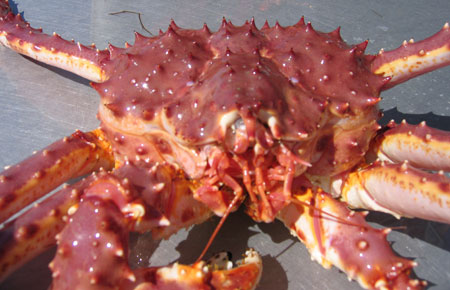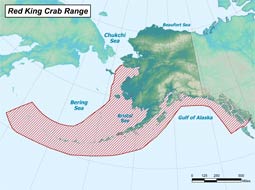Red King Crab
(Paralithodes camtschaticus)
Species Profile
Did You Know?
Red king crabs can provide many dietary benefits including a good source of protein.
General Description
Red king crabs (Paralithodes camtschaticus) are a species of large crab that appear dark red or burgundy in color. Red king crabs can grow very large with carapace (the shell covering their back) lengths up to 11 inches and a five foot leg span. Red king crabs have "tails," or abdomens, that are distinctive, being fan-shaped and tucked underneath the rear of the shell. They also have five pairs of legs; the first bears their claws or pincers, the right claw is usually the largest on the adults, the next three pairs are their walking legs, and the fifth pair of legs are small and normally tucked underneath the rear portion of their carapace. These specialized legs are used by adult females to clean their embryos (fertilized eggs) and the male uses them to transfer sperm to the female during mating.
Size and Sex Determination
Male red king crabs grow larger than females and their sex is determined by examining their abdomens. Male red king crabs have a narrow abdominal flap whereas female red king crabs have a wide abdominal flap that covers most of the underside of the abdomen.
Similar Species
Red king crabs are a member of a superfamily of decapod crustaceans also know as stone crabs. They are closely related to blue king crabs (Paralithodes platypus) and golden (brown) king crabs (Lithodes aequispinus).
Life History
Reproduction and Development
Adult females brood thousands of embryos underneath their tail flap for about a year's time. When the embryos are fully developed they hatch as swimming larvae, but they are still susceptible to the movements of tides and currents. After feeding on plant and animal plankton for several months and undergoing several body changes with each molt, the larvae settle to the ocean bottom and molt into nonswimmers, looking for the first time like king crabs as we normally think of them, except they are smaller than a dime. Red king crabs settle in waters less than 90 feet deep.
Growth
Because a crab's skeleton is its shell (made mostly of calcium), it must molt its shell in order to grow. Juveniles molt many times in their first few years, then less frequently until they reach sexual maturity in four or five years. Adult females must molt in order to mate but males do not. Adult males often skip a molt and keep the same shell for one or two years. Red king crabs can grow very large with the record female and male weighing 10.5 and 24 pounds, respectively. These large crabs were estimated to be 20–30 years old. The male's leg span was nearly 5 feet across.
Movements
Adult red king crabs exhibit near shore to offshore (or shallow to deep) and back, annual migrations. They come to shallow water in late winter and by spring the female's embryos hatch. Adult females and some adult males molt and mate before they start their offshore feeding migration to deeper waters. Adult crabs tend to segregate by sex off the mating-molting grounds. Red, blue, and golden king crabs are seldom found co-existing with one another even though the depth ranges they live in and habitats may overlap. Adult male red king crabs in the Kodiak area have been known to migrate up to 100 miles round-trip annually, moving at times as fast as a mile per day.
Range and Habitat
Red king crabs occur from British Columbia to Japan north to the Bering Sea with Bristol Bay and the Kodiak Archipelago being the centers of its abundance in Alaska. Red king crabs can occur from the intertidal zone to 100 fathoms or more.
Status, Trends, and Threats
The Bristol Bay red king crab stock has shown a trend of increasing abundance since the late 1990s. Fishing effort in this fishery has remained high with an average number of permits at 258 during 2000–2004.
Norton Sound red king crab stock has also shown a trend of increasing abundance since a recent low in the mid 1990s. The fishery provides small summer and winter fisheries with an average fishing effort of 43 permits during 2000–2004.
The Pribilof Islands red king crab fishery has been closed since 1999 due to a relatively low stock abundance, low precision of the abundance estimate and to avoid bycatch of the depleted Pribilof Islands blue king crab, as the distribution of these two species overlap.
The red king crab fisheries in Kodiak, the Alaska Peninsula, Cook Inlet, and Prince William Sound areas are closed due to low abundance. A new fishery for red king crab began in the central Aleutian Islands (Petrel Bank area) after high densities of legal crabs were encountered in a pot survey. The fishery began with a small GHL in 2002 and 2003 but was closed in 2004 and 2005.
The Southeast Alaska commercial red king crab fishery has been below threshold and closed since 2006. The personal use red king crab fishery in Southeast Alaska has been open in limited areas. The red king crab fishery in the Yakutat area remains open, but no harvest has been recorded since the 2000/2001 season due to depressed stocks.
Fast Facts
-
Size
Females up to 10.5 lbs; Males up to 24 lbs and leg span of five feet -
Lifespan
Males and females estimated to live up to 20-30 years -
Distribution/Range
British Columbia to Japan north to the Bering Sea with Bristol Bay and Kodiak Archipelago being the centers of its abundance in Alaska. -
Remarks
Red king crabs were historically the most commercially important shellfish species in Alaska. Between 1975 and 2018, U.S. crabbers harvested nearly 854 million pounds of red king crab worth $2.5 billion (not adjusted for inflation) from Alaska waters. -
Status
Healthy


